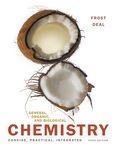
a.
To determine:
The reaction which is faster and which is slower out of the given reactions.
Introduction:
b.
To determine:
The curve which represents endergonic and which represents exergonic reaction.
Introduction:
Thermodynamics is the branch of chemistry which studies the difference of heat and energies of product and reactant in the chemical reaction. Therefore, the sign of free energy change and heat change for the given chemical reaction is predicted by using the concept of thermodynamics.
c.
To determine:
The reaction which is spontaneous out of the given reactions.
Introduction:
Thermodynamics is the branch of chemistry which studies the difference of heat and energies of product and reactant in the chemical reaction. Therefore, the sign of free energy change and heat change for the given chemical reaction is predicted by using the concept of thermodynamics.
d.
To determine:
The reaction having a positive value of free energy change out of the given reactions.
Introduction:
Thermodynamics is the branch of chemistry which studies the difference of heat and energies of product and reactant in the chemical reaction. Therefore, the sign of free energy change and heat change for the given chemical reaction is predicted by using the concept of thermodynamics.
Want to see the full answer?
Check out a sample textbook solution
Chapter 5 Solutions
EBK GENERAL, ORGANIC, AND BIOLOGICAL CH
- Question 6 Thermodynamic control of a reaction usually occurs when: A. product formation is reversible B. both possible products have low free energy C. the relative amount of free energy in each product is equivalent D. A and B only E. B and C onlyarrow_forwardWhich of the following statements is true? O Energy is required to break the bonds of the reactants and released when the bonds of the products are formed. O Energy required to form the bonds of the products and released when the bonds of the reactants break, O Energy is released when the bonds of the products are broken and required to form the bonds of the reactants. O Energy is required both for the formation of the bonds of the products as well as the breaking of the bonds of the reactants. 1 2 3 4. 6. 7 + US acerarrow_forwardLabel each reactant and product in the given chemical reaction. H2 + O2 ®H2Oarrow_forward
- Does toasting bread change the amount of calories in the bread?arrow_forwardHow does a decrease in the temperature of a chemical reaction affect the reaction rate? The reaction rate does not change. The reaction rate increases. The reaction rate decreases. How does an increase in the reactant concentration affect the reaction rate of a chemical reaction? The reaction rate decreases. The reaction rate increases. The reaction rate does not change.arrow_forwardIllustrate a three-step energy diagram using the following: a . It has two starting reactants forming a single product.b. The second step is the rate-determining step.c. The second intermediate is more stable intermediate than the first.d. The reaction is endothermic.arrow_forward
- helparrow_forwardDraw an endothermic reaction with a large EA, and a small change in H. Add the same reaction the presence of a catalyst on the same grapharrow_forwardWhich of the following is equal to the heat of a chemical reaction, regardless of how the reaction is carried out? a) Delta U + W b) DeltaH c) DeltaU d) Deltau - VW e) -Warrow_forward
- Which of the following will increase the production of Oz in the following reversible reaction?arrow_forwardWhat evidence of chemical change is visible when electricity passes through water ? How are the products of electolysis are different from the reactnt H2O?arrow_forwardRunning a mile in ten minutes burns between 100 and 120 calories for a 150-pound person. For the same run, a 200-pound person needs about 135-155 calories. In grams, how much ATP is required for this workout? ATP has a molecular mass of 507 g/mol. ATP's g-phosphate group hydrolysis has a free energy of -32 kJ/mol. One calorie is equal to 1000 calories, and one calorie is equal to 4.184 kilojoules (kJ). How much glucose do you need to fuel this run, both aerobically and anaerobically? Assume that one glucose molecule yields 30 ATP when processed aerobically. Molality of glucose is 180g/mol.arrow_forward
 Organic ChemistryChemistryISBN:9781305580350Author:William H. Brown, Brent L. Iverson, Eric Anslyn, Christopher S. FootePublisher:Cengage Learning
Organic ChemistryChemistryISBN:9781305580350Author:William H. Brown, Brent L. Iverson, Eric Anslyn, Christopher S. FootePublisher:Cengage Learning General, Organic, and Biological ChemistryChemistryISBN:9781285853918Author:H. Stephen StokerPublisher:Cengage Learning
General, Organic, and Biological ChemistryChemistryISBN:9781285853918Author:H. Stephen StokerPublisher:Cengage Learning Chemistry for Today: General, Organic, and Bioche...ChemistryISBN:9781305960060Author:Spencer L. Seager, Michael R. Slabaugh, Maren S. HansenPublisher:Cengage Learning
Chemistry for Today: General, Organic, and Bioche...ChemistryISBN:9781305960060Author:Spencer L. Seager, Michael R. Slabaugh, Maren S. HansenPublisher:Cengage Learning Chemistry & Chemical ReactivityChemistryISBN:9781337399074Author:John C. Kotz, Paul M. Treichel, John Townsend, David TreichelPublisher:Cengage Learning
Chemistry & Chemical ReactivityChemistryISBN:9781337399074Author:John C. Kotz, Paul M. Treichel, John Townsend, David TreichelPublisher:Cengage Learning Chemistry & Chemical ReactivityChemistryISBN:9781133949640Author:John C. Kotz, Paul M. Treichel, John Townsend, David TreichelPublisher:Cengage Learning
Chemistry & Chemical ReactivityChemistryISBN:9781133949640Author:John C. Kotz, Paul M. Treichel, John Townsend, David TreichelPublisher:Cengage Learning





